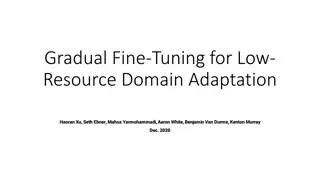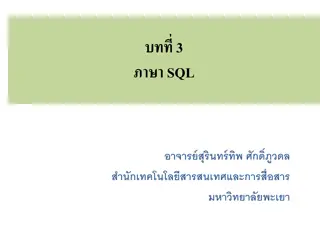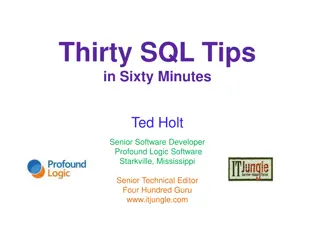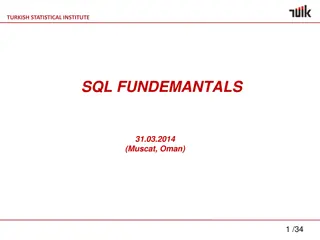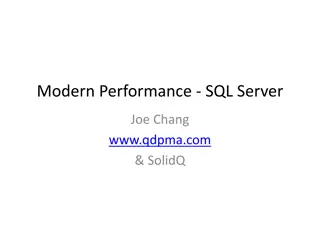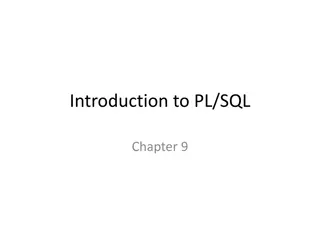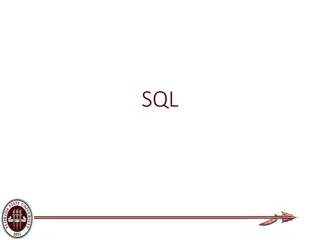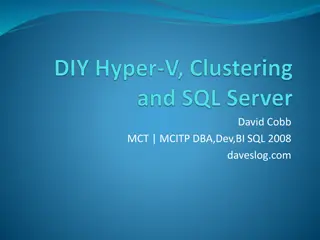
Informix SQL Performance Tips: Improving Database Efficiency
Learn essential tips for enhancing SQL performance in Informix databases. Explore techniques to identify problematic SQL statements, utilize SQL Statement Cache, and leverage tracing features for optimization. Discover expert insights on improving query performance and handling subqueries effectively for better database efficiency.
Download Presentation

Please find below an Image/Link to download the presentation.
The content on the website is provided AS IS for your information and personal use only. It may not be sold, licensed, or shared on other websites without obtaining consent from the author. If you encounter any issues during the download, it is possible that the publisher has removed the file from their server.
You are allowed to download the files provided on this website for personal or commercial use, subject to the condition that they are used lawfully. All files are the property of their respective owners.
The content on the website is provided AS IS for your information and personal use only. It may not be sold, licensed, or shared on other websites without obtaining consent from the author.
E N D
Presentation Transcript
Informix SQL Performance Tuning Tips B09 September 24 2:45pm Jeff Filippi Integrated Data Consulting, LLC jeff.filippi@itdataconsulting.com
Introduction 29 years of working with Informix products 25 years as an Informix DBA Worked for Informix for 5 years 1996 2001 Certified Informix DBA Started my own company in 2001 specializing in Informix Database Administration consulting IBM Business Partner OLTP and Data warehouse systems Informix 4 thru 14.10
Overview Identify Problem SQL Statements Tracing SQL in Informix Options Available with Set Explain & Reading sqexplain output with tuning examples Methods to use for Improving SQL Performance Subquery Support for Update/Delete External Tables
Identify Problem SQL Statements First you have to identify what SQL statements are the culprits in causing performance issues Use onstat g ntt to identify the last time read/writes occurred Gather slow SQL statements from onstats, OAT and 3rd party tools like Server Studio. Look at how many times SQL statements have been executed using SQL Statement Cache (onstat g ssc) Informix tracing feature (SQLTRACE) Review with developers known problem areas in the application Verify update statistics are current Review what tables/indexes have the most reads
Use SQL Statement Cache onstat g ssc Look at SQL's with a large number of executions. Saving even a second on a SQL statement that is executed 1 million times can make a difference in performance. New features with 14.10 for Statement Cache.
Use SQL Statement Cache IBM Informix Dynamic Server Version 11.70.FC7 -- On-Line -- Up 23 days 23:46:38 -- 2530056 Kbytes Statement Cache Summary: #lrus currsize maxsize Poolsize #hits nolimit 8 22491472 40960000 11710464 10 0 Statement Cache Entries: lru hash ref_cnt hits flag heap_ptr database user -------------------------------------------------------------------------------- 0 140 0 15 -F bb164020 ntlcom informix select descr, rowid, seq_nbr from fl_cntrl where uid in ( 'all', 'cschabel' ) and program_name in ( 'all', 'cr_inv_dl' ) and exc_type is not null order by seq_nbr 0 116 0 1011 -F aa23bc20 ntlcom informix update state_tax set row_status = "V", updt_user_id =? where seq_nbr =? And ( rec_type = 6 or rec_type = 7) 0 207 0 6003 -F a004f820 ntlcom informix select count ( *) from invoice_state where cde = "CORR" and seq_nbr =? 2 138 0 6244 -F afa9ec20 ntlcom informix select int_comm, int_comm2, updt_user_id from invoice_cmnts where seq_nbr =? and extend ( updt_dte, year to second) = ( select max ( extend ( updt_dte, year to second)) from invoice_cmnts where seq_nbr =?)
Use SQL Statement Cache Statement cache enhancements New sysmaster:syssscelem pseudo table to coincide with onstat -g ssc.For more information, see The sysmaster database. Invalidate specific statement(s) in the Statement Cache.For more information, see Monitoring usage of the SQL statement cache. Lock query plan(s) in the Statement Cache.For more information, see Monitoring usage of the SQL statement cache.
Use SQL Statement Cache Dump query plans from Statement Cache New onconfig parameter STMT_CACHE_QUERY_PLAN 0 Disabled 1 Enabled Disabled by Default WILL consume more of your STMT_CACHE_SIZE Query plan is viewable in sysaster:syssscelem.queryplan column LOOK AT Jeff McMahon s Presentation on this
Review Number of Reads on Table/Index Use the table SYSPTPROF to look at the buffer reads, page reads, sequencial scans. SELECT tabname[1,25], bufreads, pagreads, isreads, seqscans FROM sysmaster:sysptprof ORDER BY 2 desc
Example - Reads tabname bufreads pagreads isreads trnsit_1 -2122091061 429 1630786736 trnsit_1 -812314372 3162 -678524115 trnsit_1 -110705308 233 -390409810 im_p_route_1 1806427782 247 865918944 ed_rl_event 1749246222 23550 1709746386 loc_sup_data 1479941490 39 1108625557 ed_rl_event_3 1186682507 2668713 789739458 460_4902 1125173161 1003575 373042018 ed_rl_event_4 893520660 25725 886704767 im_mv_event 870108889 30477208 780365364
New Index Added tabname bufreads pagreads isreads 140_409 -845911921 0 1722690950 cntrct_num 1297728722 1 2868878 221_1360 812752007 0 406226191 ................ trnsit 17215024 22 12007375 trnsit_ix1 15638629 106 12898627 im_p_route_1 23045 347 12904
Tracing SQL in Informix There are more ways to find information to tune in Informix 11 utilizing the tracing of SQL onconfig parameter: SQLTRACE SQL Admin API Informix HQ (NEW)
Tracing SQL in Informix There are a couple ways to turn tracing on in Informix onconfig parameter: SQLTRACE level = [off,low,med,high] ntraces = [# of traces] size = [size of each trace buffer in kb] mode = [global,user] Example: SQLTRACE level=low,ntraces=1000,size=2,mode= global (This allows me to trace the last 1000 sql statements of the instance) Informix HQ
Tracing SQL in Informix Improved SQL tracing with the SQL Admin API in Informix You can use these new commands to manage SQL tracing by databases. SET SQL TRACING DATABASE ADD {Database} You can also suspend and resume all tracing at the server without de-allocating any resources. SET SQL TRACING SUSPEND/RESUME CLEAR LIST REMOVE {Database}
Tracing SQL in Informix Here is how you enable tracing thru the sysadmin database by running the following command: EXECUTE FUNCTION task( set sql tracing on ,1000,2, low , global ) To validate that tracing is turned on by: onstat g his This option prints information about the SQLTRACE configuration parameter.
Tracing SQL in Informix onstat g his IBM Informix Dynamic Server Version 11.70.FC7 -- On-Line -- Up 25 days 23:44:15 -- 2530056 Kbytes Statement history: Trace Level Low Trace Mode Global Number of traces 3000 Current Stmt ID 939412632 Trace Buffer size 2024 Duration of buffer 8241 Seconds Trace Flags 0x00001611 Control Block 9df53018
Tracing SQL in Informix Statement # 94653656: @ 9df68cb0 Database: 0x1700002 Statement text: SELECT * FROM invc_state WHERE seq_nbr = ? Iterator/Explain ================ ID Left Right Est Cost Est Rows Num Rows Type 1 0 0 26 4 6 Index Scan Statement information: Sess_id User_id Stmt Type Finish Time Run Time 7640 1001 SELECT 18:44:20 0.0006
Tracing SQL in Informix Statement Statistics: Page Buffer Read Buffer Page Buffer Write Read Read % Cache IDX Read Write Write % Cache 0 17 100.00 0 0 0 0.00 Lock Lock LK Wait Log Num Disk Memory Requests Waits Time (S) Space Sorts Sorts Sorts 13 0 0.0000 0.000 B 0 0 0 Total Total Avg Max Avg I/O Wait Avg Rows Executions Time (S) Time (S) Time (S) IO Wait Time (S) Per Sec 7294 6.6040 0.0009 0.0015 0.000000 0.000000 10869.5652 Estimated Estimated Actual SQL ISAM Isolation SQL Cost Rows , Rows Error Error Level Memory 26 4 6 0 0 LC 13416
Tracing SQL in Informix You can also get information on the tracing thru the syssqltrace table in the sysmaster database. Ex. {# of queries that ran > 2 seconds) SELECT count(*) FROM syssqltrace WHERE sql_totaltime > 2; Another useful table is the syssqltrace_iter which gives information in the form of an iteration tree for each SQL. It allows you to identify which part of the query plan took the most time to run.
Tracing SQL in Informix You can run the following SQL statement to get the SQL for the ones that have a higher run time than a second. select sql_runtime, sql_statement from sysmaster:syssqltrace where sql_runtime > .5 order by 1 desc
Tracing SQL in Informix Here is what the syssqltrace table looks like sql_id 9894804 sql_address 13746521704 sql_sid 26646 sql_uid 668 sql_stmttype 2 sql_stmtname SELECT sql_finishtime 1396011341 sql_begintxtime 301590260 sql_runtime 4.7 sql_pgreads 0 sql_bfreads 5 sql_rdcache 100.0000000000 sql_bfidxreads 0
Tracing SQL in Informix sql_pgwrites 0 sql_bfwrites 0 sql_wrcache 0.00 sql_lockreq 1 sql_lockwaits 0 sql_lockwttime 0.00 sql_logspace 0 sql_sorttotal 0 sql_sortdisk 0 sql_sortmem 0 sql_executions 1 sql_totaltime 4.7 sql_avgtime 4.7 sql_maxtime 4.7 sql_numiowaits 0 sql_avgiowaits 0.00 sql_totaliowaits 0.00 sql_rowspersec 20898.94078138
Tracing SQL in Informix sql_estcost 23 sql_estrows 46 sql_actualrows 1 sql_sqlerror 0 sql_isamerror 0 sql_isollevel 1 sql_sqlmemory 24200 sql_numiterators 1 sql_database ir_live2 sql_numtables 4 sql_tablelist systables sql_statement select owner,tabname,tabtype,tabid from informix.systables sql_stmtlen 117 sql_stmthash 206750675 sql_pdq 0 sql_num_hvars 0 sql_dbspartnum 10488544 sql_aqt None sql_aqtinfo -26500
Tracing SQL in Informix You can also save the history of the SQL tracing information. NOTE: Caution when using this, it can use a lot of space very quickly. I had a customer fill a 20 gig dbspace in 24 hours. In the Scheduler there is a new task Save SQL Trace . Information is saved in the following tables in the sysadmin database: mon_syssqltrace info) mon_syssqltrace_info (SQL Statement tracing setup info) mon_sqltrace_iter (SQL Statement iterators) (SQL Statement text and profile
Tracing SQL in Informix Here is an alternative to saving ALL tracing information. Create a task which saves SQL trace information for SQL s that have a run time of greater than 10 seconds. This allows you to still trace SQL statements, but only show you the really long running SQL statements
Tracing SQL in Informix Create a Table to save the SQL Trace information Create a new dbspace to put the table in so that if it does fill up a dbspace it does not affect any other processes. create raw table "informix".save_sqltrace ( date_time datetime year to second, sql_id int8, sql_runtime float, sql_sid int8, sql_uid int8, sql_statement char(11000), sql_database char(30) ) in sqltrace extent size 100000 next size 50000 lock mode row; create index "informix".idx_savesql1 on "informix".save_sqltrace (date_time) in sqltrace; create index "informix".idx_savesql2 on "informix".save_sqltrace (sql_runtime) in sqltrace; create index "informix".idx_savesql3 on "informix".save_sqltrace (sql_id) in sqltrace;
Tracing SQL in Informix Here is the information that needs to be inserted into the ph_task table to activate the task. In my case I was running it every minute. You will want to see what the shortest time that your trace buffer is and make the frequency the task runs smaller than that. 0|save_trace|Saves SQL Trace when run time greater than set value.|TASK|9251|||sysadmin|insert into save_sqltrace select current, sql_id, sql_runtime, sql_finishtime, sql_sid, sql_uid, sql_statement, sql_database from sysmaster:syssqltrace where (sql_runtime > 5 and (sql_finishtime > (select max(sql_finishtime) from save_sqltrace)) or (sql_runtime > 5 and ((select count(*) from save_sqltrace) = 0)));| 30 00:00:00|00:00:00|| 0 00:01:00|2014-03-27 14:54:17|9237|0|t|t|t|t|t|t|t|400|PERFORMANCE|t|0|
Use Informix HQ Use Informix HQ to look at session information to see long running SQL.
Options Available with SQEXPLAIN Optimizer Directives AVOID_EXECUTE Generate query plan without executing SQL, useful for getting query plans for inserts, updates and delete where data is manipulated, but you do not want to change data Example: set explain on AVOID_EXECUTE; SQL Statement
Options Available with Set Explain Set Explain Enhancements You can turn on/off explain statistics thru the onconfig parameter EXPLAIN_STAT . 0 Disables the display of query statistics 1 Enables the display of query statistics You can also set it with the following statement: SET EXPLAIN STATISTICS When this is enabled, the inclusion of the Query Statistics section in the explain output file. It shows the query plan s estimated number of rows and the actual number of rows returned.
Options Available with Set Explain Query Statistics QUERY: ------ select * from partsupp where ps_partkey >= 1 and ps_partkey <= 100 and ps_suppkey >= 0 and ps_suppkey <= 100000 and ps_availqty >= 1000 and ps_availqty <= 1000000 Estimated Cost: 49 Estimated # of Rows Returned: 360 1) informix.partsupp: INDEX PATH (1) Index Keys: ps_partkey ps_suppkey ps_availqty (Key-First) (Serial, fragments: ALL) Lower Index Filter: informix.partsupp.ps_partkey >= 1 AND (informix.partsupp.ps_availqty >= 1000 ) AND (informix.partsupp.ps_suppkey >= 0 ) Upper Index Filter: informix.partsupp.ps_partkey <= 100 AND (informix.partsupp.ps_availqty <= 1000000 ) AND (informix.partsupp.ps_suppkey <=100000 ) Index Key Filters: (informix.partsupp.ps_availqty >= 1000 ) AND (informix.partsupp.ps_availqty <= 1000000 ) AND (informix.partsupp.ps_suppkey <= 100000 ) AND (informix.partsupp.ps_suppkey >= 0 ) Query statistics: ----------------- Table map : ---------------------------- Internal name Table name -------------------------------------- t1 partsupp type table rows_prod est_rows rows_scan time est_cost ------------------------------------------------------------------------------------------------ scan t1 26 360 26 00:00:00 49
Dynamic Set Explain Dynamically set explain on for a session onmode Y {session id} {0|1} Output is to a file sqexplain.out.{session id} With Informix 11 there are a couple changes: An additional value 2 (explain without statistics for session, displays query plan only) Also you can specify the file name and directory that you want the explain output to be sent: onmode Y {session id} {0|1|2} {filename} (0 Off/1 On) This is a great feature to allow you to see the SQL statements executed and the explain plan for each SQL statement. NOTE: make sure that you only have this turned on for a short period of time, it creates a large file.
Set Explain Output Add set explain on before the statement you want to examine You can specify the directory that you want the file to go: set explain file to filename Review the set explain output: UNIX: The file sqexplain.out will be generated in the directory that you run the query from Windows: Look for a file username.out in the directory on the UNIX server %INFORMIXDIR%\sqexpln
Set Explain Output Query Displays the executed query and indicates whether set optimization was set to high or low Directives Followed Lists any directives used for the query Estimated Cost An estimated of the amount of work for the query. The number does not translate into time. Only compare to same query not others. Estimated number of rows returned An estimate of the number of rows returned, number based on information from system catalog tables
Set Explain Output Numbered List The order in which tables are accessed, followed by the access method (index or sequential scan) Index Keys The columns used as filters or indexes Query Statistics Enabled by onconfig parameter EXPLAIN_STAT
Examples of Explain Plans The following slides will show tuning of SQL based on the following scenarios: Functions causing index to not be used Criteria from views causing sequential scans Using in causes sequential scans Use of Directives Use of substrings in queries Use of functions in queries Using a better index (Creation of new index)
Functions cause index to not be used QUERY: ------ SELECT DISTINCT BUSINESS_UNIT, VOUCHER_ID, INVOICE_ID, GROSS_AMT, INVOICE_DT, VENDOR_NAME_SHORT, VENDOR_ID, NAME1, VOUCHER_STYLE, ENTRY_STATUS_SRH FROM PS_VOUCHER_SRCH_VW WHERE BUSINESS_UNIT= GH' AND UPPER(INVOICE_ID) LIKE UPPER('KURT') || '%' ESCAPE '\' ORDER BY INVOICE_ID, BUSINESS_UNIT, VOUCHER_ID DESC FOR READ ONLY Estimated Cost: 55943 Estimated # of Rows Returned: 1 Temporary Files Required For: Order By 1) sysadm.ps_vendor: SEQUENTIAL SCAN 2) sysadm.ps_voucher: INDEX PATH Filters: (sysadm.ps_voucher.entry_status IN ('P' , 'R' , 'T' )AND UPPER(sysadm.ps_voucher.invoice_id ) LIKE 'KURT%' ESCAPE '\' ) (1) Index Keys: vendor_id vendor_setid business_unit (Serial, fragments: ALL) Lower Index Filter: ((sysadm.ps_voucher.vendor_id = sysadm.ps_vendor.vendor_id AND sysadm.ps_voucher.vendor_setid = sysadm.ps_vendor.setid ) AND sysadm.ps_voucher.business_unit = GH' ) NESTED LOOP JOIN
Resolution: Function causes index to not be used QUERY: ------ SELECT DISTINCT BUSINESS_UNIT, VOUCHER_ID, INVOICE_ID, GROSS_AMT, INVOICE_DT, VENDOR_NAME_SHORT, VENDOR_ID, NAME1, VOUCHER_STYLE, ENTRY_STATUS_SRH FROM PS_VOUCHER_SRCH_VW WHERE BUSINESS_UNIT= GH' AND INVOICE_ID LIKE 'KURT' || '%' ESCAPE '\' ORDER BY INVOICE_ID, BUSINESS_UNIT, VOUCHER_ID DESC FOR READ ONLY Estimated Cost: 35009 Estimated # of Rows Returned: 1 Temporary Files Required For: Order By 1) sysadm.ps_voucher: INDEX PATH Filters: sysadm.ps_voucher.entry_status IN ('P' , 'R' , 'T' ) (1) Index Keys: business_unit invoice_id (Serial, fragments: ALL) Lower Index Filter: (sysadm.ps_voucher.business_unit = GH' AND sysadm.ps_voucher.invoice_id LIKE 'KURT%' ESCAPE '\' ) 2) sysadm.ps_vendor: INDEX PATH (1) Index Keys: vendor_id setid (Serial, fragments: ALL) Lower Index Filter: (sysadm.ps_voucher.vendor_id = sysadm.ps_vendor.vendor_id AND sysadm.ps_voucher.vendor_setid = sysadm.ps_vendor.setid ) NESTED LOOP JOIN
Resolution: Function causes index to not be used Another way is to add a function which converts a character to all upper case and change the index to include the use of the function. CREATE FUNCTION upper_idx(char_up char(20)) RETURNING char(20) WITH (not variant); DEFINE char_out char(20); LET char_out = upper(char_up); RETURN char_out; END FUNCTION; CREATE INDEX upper_idx on ps_vendor(business_unit, (upper_idx(invoice_id)) USING btree;
Criteria used to select from views causes Sequential Scans QUERY: ------ SELECT BUSINESS_UNIT,INV_ITEM_ID,CM_BOOK,DT_TIMESTAMP,SEQ_NBR, CM_DT_TIMESTAMP_A,CM_SEQ_NBR_A,CM_ORIG_TRANS_DATE,CONSIGNED_FLAG, STORAGE_AREA,INV_LOT_ID,SERIAL_ID,CM_RECEIPT_QTY,CM_DEPLETE_QTY, CM_ONHAND_QTY FROM PS_CM_ONHAND_VW WHERE BUSINESS_UNIT = 'RPRO' AND INV_ITEM_ID = '05-04-CVC-6-KINS' AND CM_BOOK = 'FIN' AND CONSIGNED_FLAG = 'N' AND CM_ONHAND_QTY > 0 ORDER BY CM_ORIG_TRANS_DATE, CM_DT_TIMESTAMP_A, CM_SEQ_NBR_A FOR READ ONLY Estimated Cost: 8425 Estimated # of Rows Returned: 1 Temporary Files Required For: Order By Group By 1) sysadm.ps_cm_deplete:SEQUENTIAL SCAN 2) sysadm.ps_cm_receipts: INDEX PATH (1) Index Keys: business_unit inv_item_id cm_book dt_timestamp seq_nbr cm_dt_timestamp_a cm_seq_nbr_a (Serial, fragments: ALL) Lower Index Filter: ((((((sysadm.ps_cm_receipts.dt_timestamp = sysadm.ps_cm_deplete.cm_dt_timestamp AND sysadm.ps_cm_receipts.cm_dt_timestamp_a = sysadm.ps_cm_deplete.cm_dt_timestamp_a ) AND sysadm.ps_cm_receipts.inv_item_id = sysadm.ps_cm_deplete.inv_item_id ) AND sysadm.ps_cm_receipts.seq_nbr = sysadm.ps_cm_deplete.cm_seq_nbr ) AND sysadm.ps_cm_receipts.cm_seq_nbr_a = sysadm.ps_cm_deplete.cm_seq_nbr_a ) AND sysadm.ps_cm_receipts.business_unit = sysadm.ps_cm_deplete.business_unit ) AND sysadm.ps_cm_receipts.cm_book = sysadm.ps_cm_deplete.cm_book ) NESTED LOOP JOIN
Resolution to Criteria used for view causes Sequential Scans QUERY: SELECT BUSINESS_UNIT,INV_ITEM_ID,CM_BOOK,DT_TIMESTAMP,SEQ_NBR, CM_DT_TIMESTAMP_A,CM_SEQ_NBR_A,CM_ORIG_TRANS_DATE,CONSIGNED_FLAG, STORAGE_AREA,INV_LOT_ID,SERIAL_ID,CM_RECEIPT_QTY,CM_DEPLETE_QTY, CM_ONHAND_QTY FROM PS_CM_ONHAND_VW WHERE BUSINESS_UNIT = 'RPRO' AND INV_ITEM_ID = '04X35-X-042' AND CM_BOOK = 'FIN' AND CONSIGNED_FLAG = 'N' --AND CM_ONHAND_QTY > 0 ORDER BY CM_ORIG_TRANS_DATE, CM_DT_TIMESTAMP_A, CM_SEQ_NBR_A FOR READ ONLY Estimated Cost: 10 Estimated # of Rows Returned: 1 Temporary Files Required For: Order By Group By 1) sysadm.ps_cm_deplete: INDEX PATH (1) Index Keys: business_unit inv_item_id cm_book dt_timestamp seq_nbr cm_dt_timestamp cm_seq_nbr cm_dt_timestamp_a cm_seq_nbr_a (Serial, fragments: ALL) Lower Index Filter: ((sysadm.ps_cm_deplete.inv_item_id = '04X35-X-042' AND sysadm.ps_cm_deplete.business_unit = 'RPRO' ) AND sysadm.ps_cm_deplete.cm_book = 'FIN' ) 2) sysadm.ps_cm_receipts: INDEX PATH Filters: sysadm.ps_cm_receipts.consigned_flag = 'N' (1) Index Keys: business_unit inv_item_id cm_book dt_timestamp seq_nbr cm_dt_timestamp_a cm_seq_nbr_a (Serial, fragments: ALL) Lower Index Filter: ((((((sysadm.ps_cm_receipts.inv_item_id = sysadm.ps_cm_deplete.inv_item_id AND sysadm.ps_cm_receipts.dt_timestamp = sysadm.ps_cm_deplete.cm_dt_timestamp ) AND sysadm.ps_cm_receipts.seq_nbr = sysadm.ps_cm_deplete.cm_seq_nbr ) AND sysadm.ps_cm_receipts.cm_dt_timestamp_a = sysadm.ps_cm_deplete.cm_dt_timestamp_a ) AND sysadm.ps_cm_receipts.cm_seq_nbr_a = sysadm.ps_cm_deplete.cm_seq_nbr_a ) AND sysadm.ps_cm_receipts.business_unit = sysadm.ps_cm_deplete.business_unit ) AND sysadm.ps_cm_receipts.cm_book = sysadm.ps_cm_deplete.cm_book ) NESTED LOOP JOIN
View used in Query CREATE VIEW "sysadm".ps_cm_onhand_vw (business_unit,inv_item_id,cm_book,dt_timestamp,seq_nbr,cm_dt_timestamp_a, . cm_onhand_qty) AS SELECT x1.business_unit ,x1.inv_item_id ,x1.cm_book ,x1.cm_dt_timestamp, . (x0.qty_base - sum(x1.qty_base) ) FROM "sysadm".ps_cm_receipts x0 ,"sysadm".ps_cm_deplete x1 WHERE (((((((x0.business_unit = x1.business_unit ) AND (x0.inv_item_id = x1.inv_item_id ) ) AND (x0.cm_book = x1.cm_book) ) AND (x0.dt_timestamp = x1.cm_dt_timestamp ) ) AND (x0.seq_nbr = x1.cm_seq_nbr ) ) AND (x0.cm_dt_timestamp_a = x1.cm_dt_timestamp_a) ) AND (x0.cm_seq_nbr_a = x1.cm_seq_nbr_a ) ) GROUP BY x1.business_unit ,x1.inv_item_id ,x1.cm_book ,x1.cm_dt_timestamp , x1.cm_seq_nbr,x0.cm_dt_timestamp_a ,x0.cm_seq_nbr_a , x0.cm_orig_trans_date,x0.consigned_flag ,x0.storage_area , x0.inv_lot_id ,x0.serial_id,x0.qty_base ;
Using in causes Sequential Scans QUERY: ----------------- SELECT inv3_invno FROM inv3 WHERE 448050 IN (inv3_physcode,inv3_altphys1,inv3_altphys2) Estimated Cost: 157852 Estimated # of Rows Returned: 566880 1) informix.cus3: SEQUENTIAL SCAN Filters: 448050 IN (informix.inv3.inv3_physcode , informix.inv3.inv3_altphys1 , informix.inv3.inv3_altphys2 ) Query statistics: ----------------- Table map : ---------------------------- Internal name Table name ---------------------------- t1 inv3 type table rows_prod est_rows rows_scan time est_cost ------------------------------------------------------------------- scan t1 21 566880 2096652 00:01.26 157852
Resolution to Criteria used for Using in Causes Sequential Scans First I create two new indexes create index ixinv3_altphys1 on inv3(inv3_altphys1) create index ixinv3_altphys2 on inv3(inv3_altphys2) Then I changed the query to use or instead of in
Resolution to Criteria used for Using in Causes Sequential Scans QUERY: ------ SELECT inv3_invno FROM inv3 WHERE (inv3_physcode = 448050 or inv3_altphys1 = 448050 or inv3_altphys2 = 448050) Estimated Cost: 13 Estimated # of Rows Returned: 9 1) informix.inv3: INDEX PATH (1) Index Name: informix.ixinv3_physcode Index Keys: inv3_physcode (Serial, fragments: ALL) Lower Index Filter: informix.inv3.inv3_physcode = 448050 (2) Index Name: informix.ixinv3_altphys2 Index Keys: inv3_altphys2 (Serial, fragments: ALL) Lower Index Filter: informix.inv3.inv3_altphys2 = 448050 (3) Index Name: informix.ixinv3_altphys1 Index Keys: inv3_altphys1 (Serial, fragments: ALL) Lower Index Filter: informix.inv3.inv3_altphys1 = 448050
Resolution to Criteria used for Using in Causes Sequential Scans Query statistics: ----------------- Table map : ---------------------------- Internal name Table name ---------------------------- t1 inv3 type table rows_prod est_rows rows_scan time est_cost ---------------------------------------------------------------------------------- scan t1 21 9 21 00:00.24 13
Use of Directives for Queries QUERY: ------ SELECT D.BUSINESS_UNIT, D.VENDOR_SETID, E.VENDOR_ID, E.NAME1, E.NAME2, VNDR_LOC FROM PS_PAYMENT_TBL A, PS_PYMNT_VCHR_XREF B, PS_VOUCHER_LINE C, PS_VOUCHER D, PS_VENDOR E, PS_VENDOR_LOC F WHERE A.BANK_SETID = B.BANK_SETID AND A.BANK_CD = B.BANK_CD AND A.BANK_ACCT_KEY = B.BANK_ACCT_KEY AND A.PYMNT_ID = B.PYMNT_ID AND B.BUSINESS_UNIT = C.BUSINESS_UNIT AND B.VOUCHER_ID = C.VOUCHER_ID AND C.BUSINESS_UNIT = D.BUSINESS_UNIT AND C.VOUCHER_ID = D.VOUCHER_ID AND E.VENDOR_ID = D.VENDOR_ID AND A.PYMNT_STATUS = 'P' AND A.PYMNT_DT BETWEEN '01-01-2003' AND '12-31-2003' AND D.BUSINESS_UNIT IN ('CAT', SNCPY') AND E.SETID = F.SETID AND E.VENDOR_ID = F.VENDOR_ID AND C.WTHD_CD <> F.WTHD_CD Estimated Cost: 57005 Estimated # of Rows Returned: 1
Use of Directives in Queries 1) informix.f: INDEX PATH Filters: informix.f.effdt = <subquery> (1) Index Keys: setid vendor_id vndr_loc effdt (desc) eff_status (Serial, fragments: ALL) 2) informix.e: INDEX PATH (1) Index Keys: vendor_id setid (Serial, fragments: ALL) Lower Index Filter: (informix.e.vendor_id = informix.f.vendor_id AND informix.e.setid = informix.f.setid ) NESTED LOOP JOIN 3) informix.d: INDEX PATH Filters: informix.d.business_unit IN ('CAT' , SNCPY' ) (1) Index Keys: vendor_id vendor_setid entry_status (Serial, fragments: ALL) Lower Index Filter: informix.d.vendor_id = informix.f.vendor_id NESTED LOOP JOIN 4) informix.c: INDEX PATH Filters: informix.c.wthd_cd != informix.f.wthd_cd (1) Index Keys: business_unit voucher_id (desc) voucher_line_num (Serial, fragments: ALL) Lower Index Filter: (informix.c.voucher_id = informix.d.voucher_id AND informix.c.business_unit = informix.d.business_unit ) NESTED LOOP JOIN 5) informix.b: INDEX PATH (1) Index Keys: business_unit voucher_id (desc) pymnt_id bank_cd bank_acct_key (Serial, fragments: ALL) Lower Index Filter: (informix.b.voucher_id = informix.c.voucher_id AND informix.b.business_unit = informix.d.business_unit ) NESTED LOOP JOIN 6) informix.a: INDEX PATH Filters: ((informix.a.pymnt_dt >= 01/01/2003 AND informix.a.pymnt_status = 'P' ) AND informix.a.pymnt_dt <= 12/31/2003 ) (1) Index Keys: pymnt_id (desc) bank_acct_key bank_cd bank_setid (Serial, fragments: ALL) Lower Index Filter: (((informix.a.pymnt_id = informix.b.pymnt_id AND informix.a.bank_acct_key = informix.b.bank_acct_key ) AND informix.a.bank_cd = informix.b.bank_cd ) AND informix.a.bank_setid = informix.b.bank_setid ) NESTED LOOP JOIN


